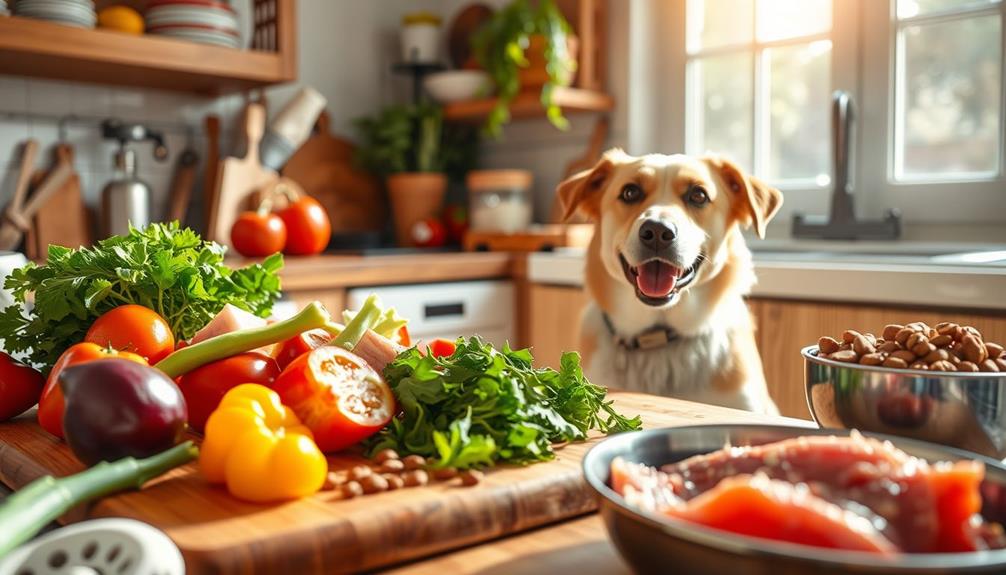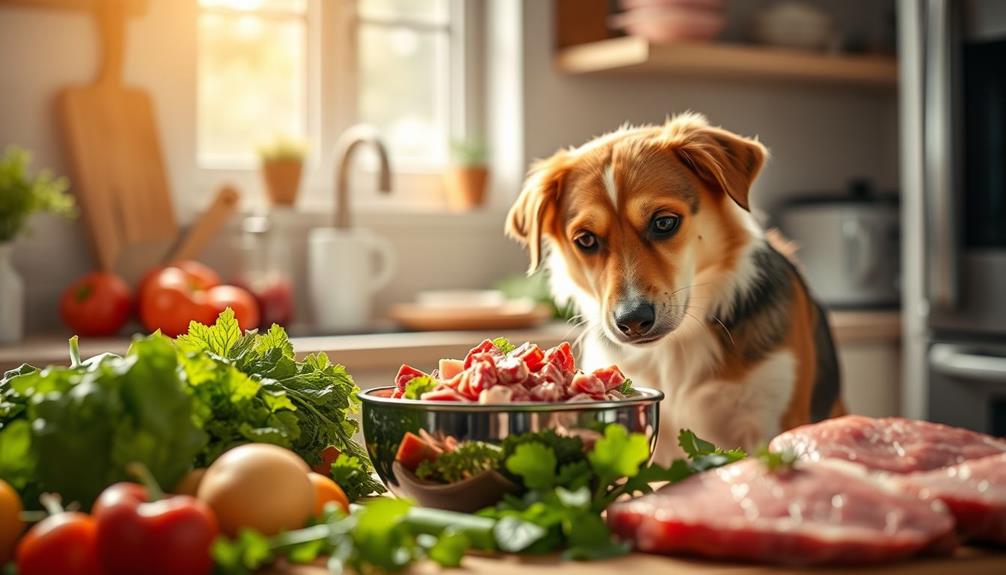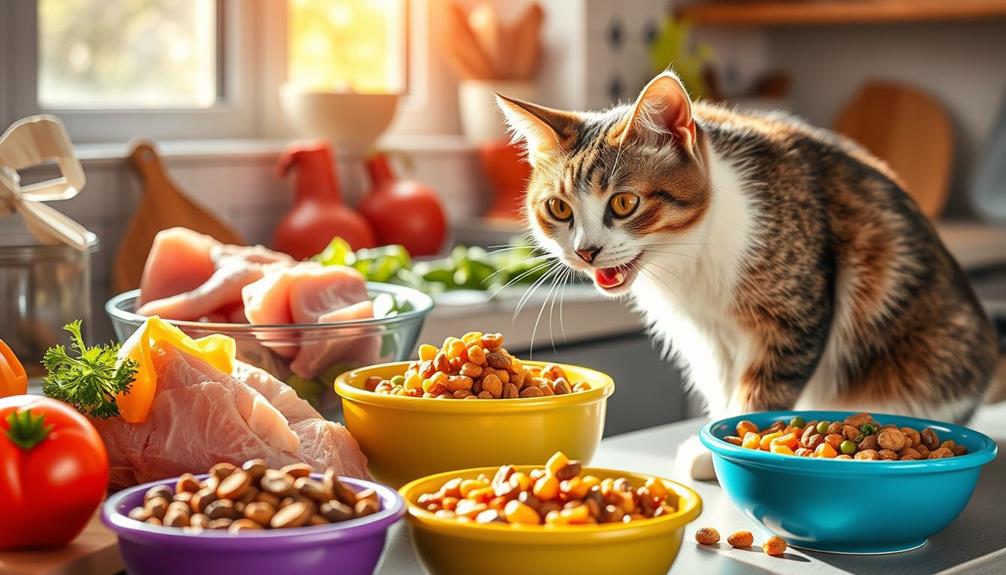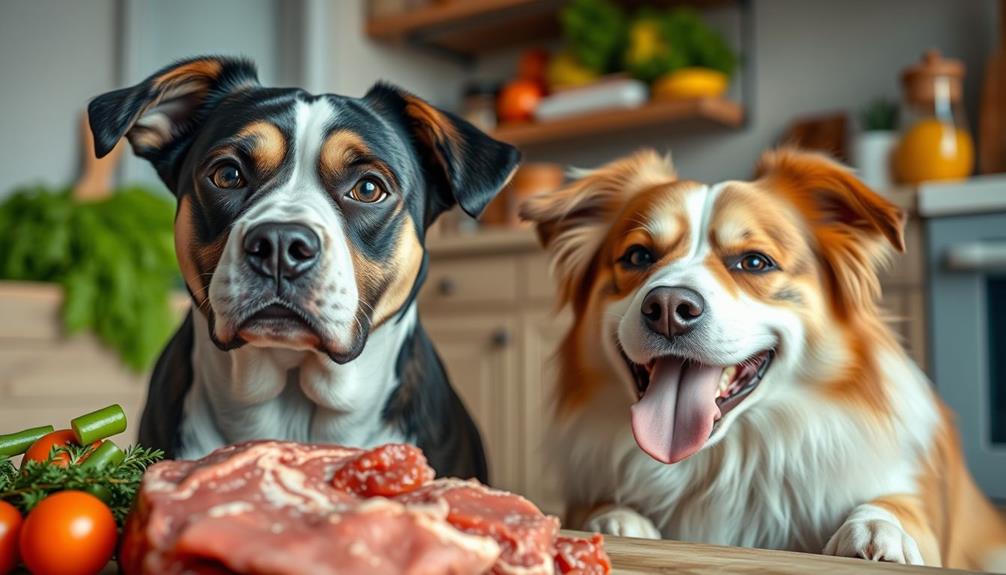You can feed your dog raw food, but it's important to do your homework first. Raw diets can improve digestion, coat health, and energy levels, but they must be nutritionally balanced. You should consult a veterinary nutritionist before starting to avoid potential deficiencies and health risks. When shifting to raw food, take it slow by gradually mixing in raw options with your dog's current diet. Hygiene is vital, as raw food can carry harmful bacteria. Monitoring your dog's health throughout the process is essential, and there are many tips to guarantee a successful shift that you might find helpful. It’s also important to consider your dog’s individual health and any pre-existing conditions when deciding whether a raw diet is appropriate. Additionally, you may be wondering, “Can puppies eat raw food?” It’s best to consult with a veterinarian before introducing raw food to a puppy’s diet, as their nutritional needs are different from adult dogs. They may require additional nutrients for growth and development that need to be carefully considered in a raw diet.
Key Takeaways
- Consult a veterinary nutritionist before starting a raw food diet to ensure nutritional balance and prevent deficiencies.
- Transition to raw food gradually to avoid digestive issues, starting with a mix of 25% raw and 75% current diet.
- Monitor your dog's health closely during the transition, including gastrointestinal status, weight, and energy levels.
- Choose raw food that meets AAFCO standards and prioritize safety by investigating ingredient sourcing and handling practices.
- Be aware of potential contamination risks with raw food, as 25% of samples may harbor harmful bacteria.
Understanding Raw Dog Food
Understanding raw dog food involves recognizing that it's primarily made up of uncooked meat, organs, and bones, reflecting the natural diet of dogs. Raw meat-based diets have gained popularity, with 15%-25% of dogs now being fed this way.
As a pet owner, you might be drawn to the health benefits these diets promise, but it's vital to guarantee your dog's diet is nutritionally balanced. Just like with hamsters, where proper diet and care are significant, dogs also require careful attention to their nutritional needs to prevent health issues. proper diet for pets can make a substantial difference in their overall well-being.
Types of raw food diets vary widely and include options like home-prepared, commercially frozen, freeze-dried, dehydrated, and high-pressure pasteurized. Each type requires careful nutritional consideration to maintain the proper ratio of muscle meat, organs, and bones to prevent deficiencies.
Companies like We Feed Raw offer correctly proportioned options, making it easier for you to choose.
Before you start feeding raw food, consulting with a veterinary nutritionist is significant. They can help you navigate the complexities of a raw diet and address any potential health risks your dog might face. Small dogs and raw food can be especially challenging, as their smaller size may make them more susceptible to certain bacteria found in raw meat. A veterinary nutritionist can provide personalized recommendations for the best types of raw food to feed your small dog, as well as any necessary supplements to ensure they are receiving a balanced diet. Additionally, they can also advise on proper food handling and safety measures to reduce the risk of foodborne illness for both your dog and your family.
Benefits of a Raw Diet
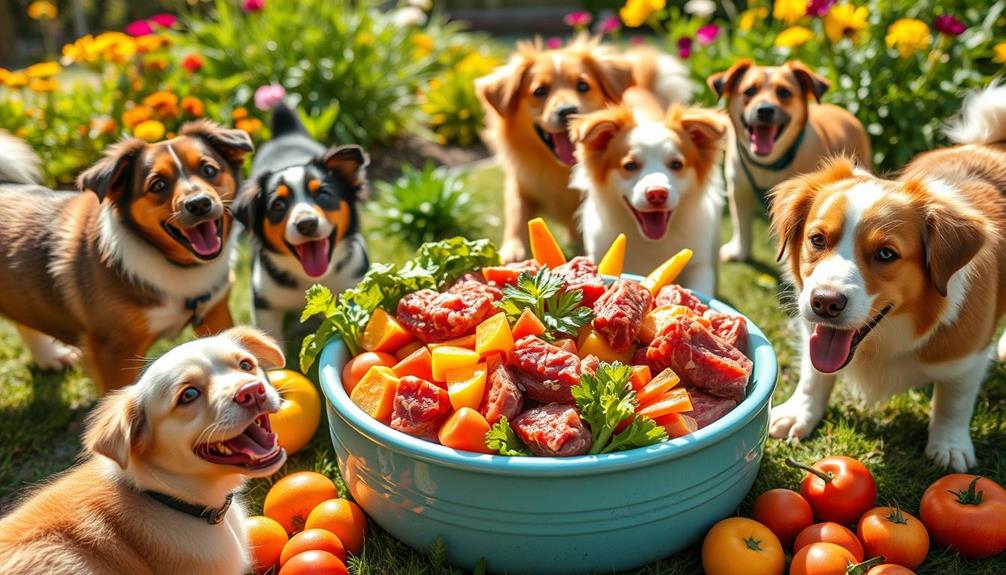
Switching to a raw diet can lead to noticeable health improvements for your dog, from a shinier coat to better digestion.
Many pet owners also see a boost in energy levels and overall vigor.
Additionally, incorporating healthy dog snacks into their raw diet can enhance their mealtime experience.
Plus, your dog might enjoy mealtime even more, as this diet reflects their natural eating habits.
Health Improvements Overview
Many dog owners report significant health improvements after converting their pets to a raw food diet. One of the most noticeable changes is enhanced skin and coat health. The moisture and healthy fats in raw foods often lead to shinier fur and reduced skin issues.
Additionally, the rich nutrients in raw diets can be compared to the health benefits seen with Cranberry Juice Consumption, which is known for its positive effects on overall health. You'll also find that your dog's dental health improves, as the natural chewing involved in raw diets helps minimize plaque and tartar buildup.
Additionally, many owners notice their dogs have smaller, firmer stools, indicating better digestion and improved nutrient absorption. This can also lead to a reduction in food allergies, as raw diets allow you to choose limited ingredients that cater to your dog's natural dietary needs.
You may observe an increase in your dog's energy level, contributing to an overall better quality of life. Many pets become more playful and active after switching to a raw food diet, which can strengthen your bond through more engaging activities.
Enhanced Vitality Benefits
Enhanced energy is one of the most compelling benefits of a raw food diet for dogs. When you switch to raw food, you may notice a significant boost in your dog's vigor and energy levels. This increase stems from the natural nutrients found in raw ingredients, which are more easily absorbed by their bodies compared to kibble or cooked diets. Additionally, beneficial nutrition guidelines can help you make informed choices about your dog's diet and overall health.
You'll likely observe improvements in your dog's coat condition as well. The moisture and healthy fats in raw meat contribute to shinier, healthier fur. Additionally, a raw diet promotes better digestion and nutrient absorption, often leading to smaller and firmer stools due to the high digestibility of raw ingredients.
Dental health can also benefit from a raw food regimen. The natural enzymes in raw food help reduce plaque buildup, resulting in fresher breath for your furry friend.
Furthermore, many dog owners report that their pets exhibit increased mealtime excitement and satisfaction when fed raw, enhancing their overall quality of life. By focusing on these aspects, you can guarantee your dog's health and well-being thrive with a raw food diet.
Safety and Quality Concerns
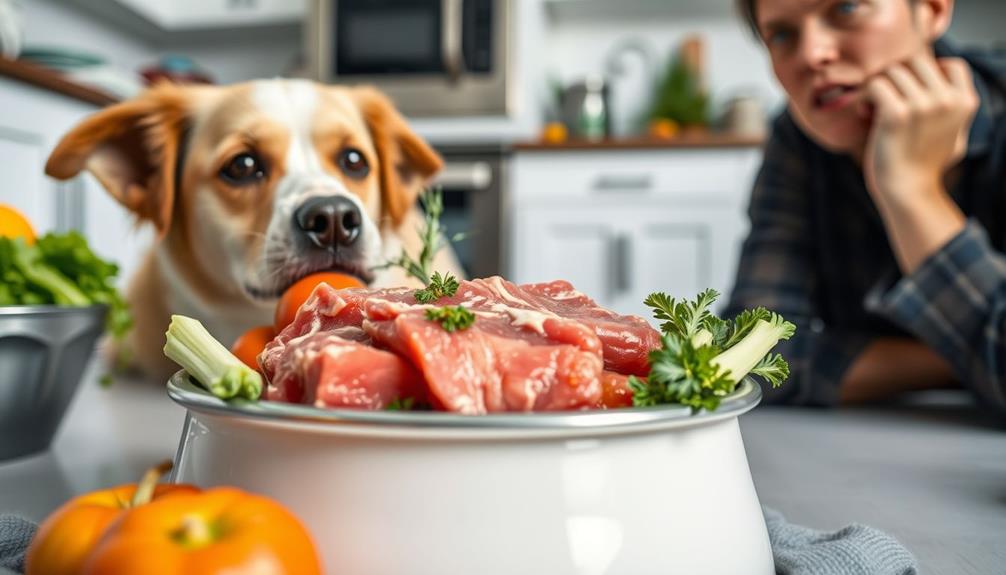
When considering a raw meat-based diet (RMBD) for your dog, it's important to understand the safety and quality concerns that come with it. Here are four significant points to keep in mind:
1. Bacterial Contamination: Studies show that 25% of raw food samples can be contaminated with harmful bacteria like Salmonella and Listeria monocytogenes, posing risks to both you and your dog.
Additionally, just as maintaining air quality is important through proper air purifier maintenance, guaranteeing the cleanliness of your dog's food preparation area is equally important to reduce contamination risks air purifier maintenance.
2. Safety Precautions: Proper hygiene practices are essential when handling raw food. Always wash your hands, disinfect surfaces, and use separate utensils to minimize risks.
3. Nutritional Deficiencies: Raw diets may not meet AAFCO nutrient profiles, leading to potential nutritional deficiencies. This is particularly true for products from smaller, unregulated companies.
4. Veterinary Check-Ups: Regular veterinary check-ups are significant for dogs on raw diets. They help monitor health and confirm that your dog's nutritional needs are being met safely and effectively.
Considering high-pressure processing (HPP) can also enhance the safety of raw dog food without compromising quality.
Transitioning to Raw Food
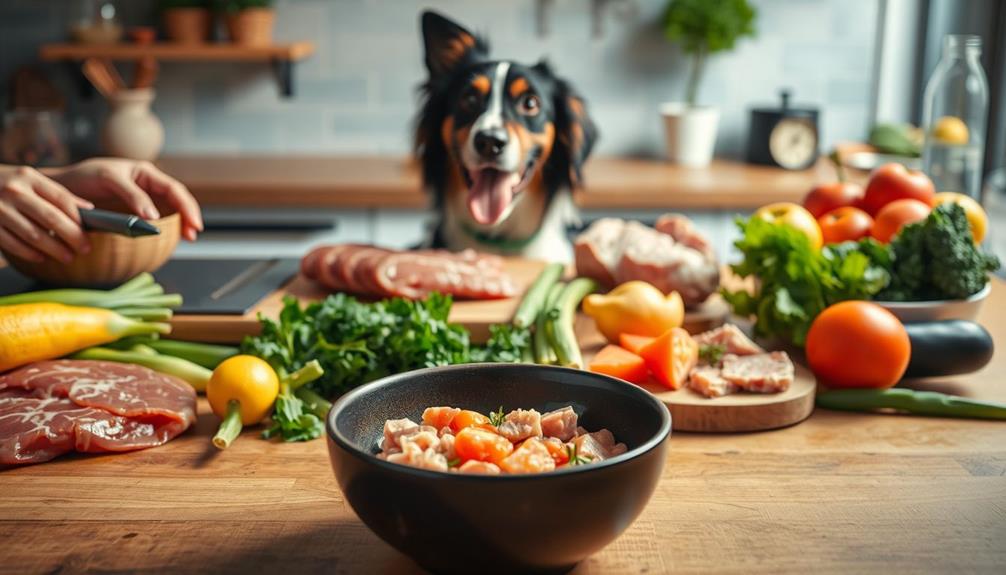
Shifting your dog to raw food requires a careful approach to avoid digestive issues.
It's important to guarantee that the new diet meets your dog's nutritional needs, which may involve considering factors like financial considerations for elderly care if you have multiple pets.
Start with a gradual mix of their current diet and raw food, monitoring their health closely throughout the process.
Adjust portion sizes based on your dog's weight and activity, and consult with a vet to guarantee a balanced diet.
Transition Process Steps
The journey to a raw food diet for your dog begins with a careful change to guarantee their digestive system adjusts smoothly. A gradual shift is key, so follow these steps:
It's important to remember that every dog's digestive health may react differently to dietary changes, so be vigilant and responsive to their needs, especially during this shift phase. Additionally, developmental milestones assessed can also apply to dietary adjustments in pets, as they adapt to new foods over time.
- Days 1-3: Mix 25% raw food with 75% of your dog's current diet. This helps ease them into the new food.
- Days 4-6: Increase the raw food to 50%. Keep an eye on their health and any signs of digestive discomfort.
- Days 7-9: Change to 75% raw and 25% old diet. Monitor your dog's reactions closely; some may need a slower shift.
- Day 10: Aim for a complete raw food diet. Make sure your dog feels comfortable throughout this process to prevent stomach issues.
It's essential to consult a veterinary nutritionist during this shift to guarantee a proper nutritional balance. They can guide you on how to meet your dog's specific dietary needs.
With patience and careful monitoring, your dog can successfully adjust to their new raw food diet!
Monitoring Health Changes
As you move forward with your dog's raw food diet, keeping a close eye on their health is important. Monitoring your dog's gastrointestinal status is essential, so watch for any signs of vomiting or diarrhea during the changeover. These symptoms can indicate an adjustment issue that needs addressing.
It's also beneficial to incorporate essential oils for health into your dog's routine, as they may support overall wellness during this dietary shift.
It's also important to track your dog's weight and overall body condition. Aim for gradual changes rather than sudden weight fluctuations, which can signal nutritional imbalances. Pay attention to your dog's energy levels; an increase in liveliness might suggest a positive response to the new diet, while lethargy could indicate the need for dietary adjustments.
Regular veterinary check-ups are recommended, especially during this changeover period. These visits confirm nutritional adequacy and help address any health concerns that may arise.
Don't forget to document health changes, including stool quality and overall demeanor. This information will facilitate discussions with your veterinarian and assist you in making informed decisions about your dog's raw food diet.
Choosing the Right Raw Food
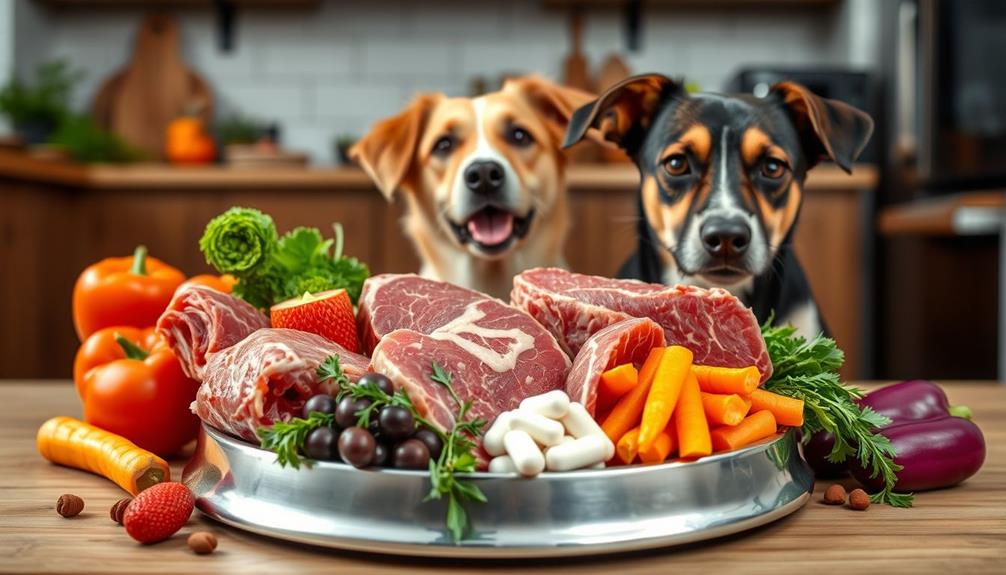
Selecting the right raw food for your dog can greatly impact their health and well-being. Here are four key factors to take into account when choosing raw dog foods:
- AAFCO Standards: Confirm the raw food diet meets the nutritional needs outlined by AAFCO standards for ideal health. Just as butter can enhance flavor and moisture in cooking, high-quality ingredients in raw dog food can greatly improve your dog's overall health.
- Ingredient Sourcing: Investigate where the ingredients come from to affirm you're getting high-quality meat and to minimize the risk of bacterial contamination. Look for food safety practices that reflect the same care taken in sourcing premium butter for cooking.
- Food Safety Practices: Look for companies that clearly communicate their food safety practices and maintain a transparent supply chain to build trust in the product's quality.
- Convenience & Customization: Think about subscription services that provide regular deliveries, variety in meal options, and customization based on your dog's specific health requirements.
Consulting a veterinary nutritionist can help you determine if additional nutrients are necessary to achieve a balanced diet, especially for dogs with specific health concerns.
Veterinary Guidance and Support
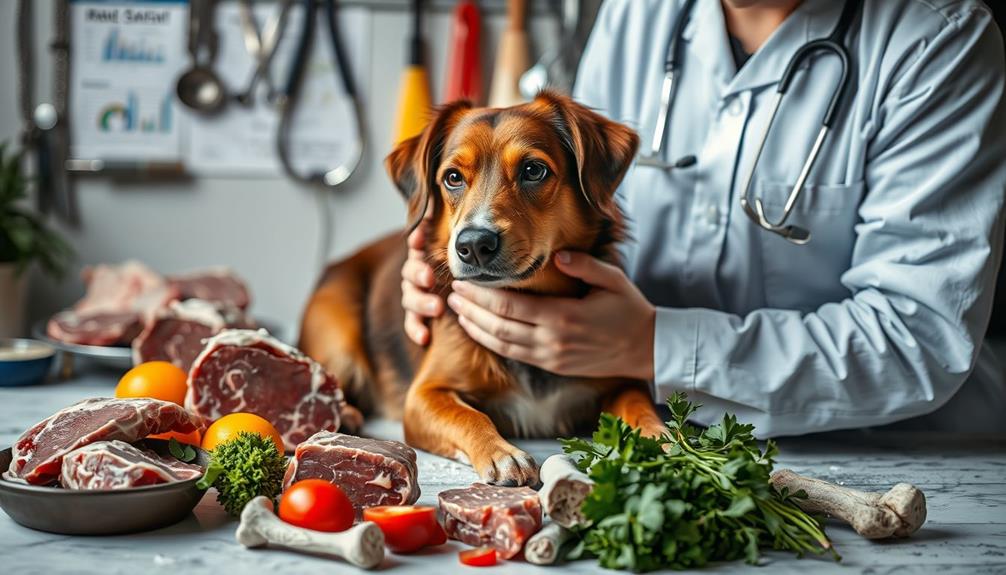
Veterinary guidance plays an essential role in making certain your dog thrives on a raw food diet. Since many veterinarians receive limited education on pet nutrition, it's vital to consult with a veterinary nutritionist. They can help balance raw diets to meet AAFCO nutrient profiles, addressing potential deficiencies and avoiding health problems.
Regular veterinary check-ups are recommended for dogs on raw diets. These visits allow for monitoring of your dog's health and detection of nutritional imbalances early on. Veterinarians should provide education on the risks and benefits of raw diets, fostering open communication to align dietary choices with your pet's health needs.
Here's a helpful table summarizing key aspects of veterinary guidance:
| Aspect | Importance | Action Required |
|---|---|---|
| Consulting | Makes certain balanced raw diets | Work with a veterinary nutritionist |
| Regular Check-Ups | Detects health problems early | Schedule routine vet visits |
| Open Communication | Aligns diet with health needs | Discuss concerns with your vet |
| Dietary Recommendations | Prevents nutritional imbalances | Follow vet's tailored advice |
| Risks and Benefits | Informed decisions about raw diets | Evaluate pros and cons |
Frequently Asked Questions
What Are the Guidelines for Raw Food for Dogs?
When considering raw food for your dog, gradually shift their diet, make certain you include meat, organs, and bones, and consult a veterinary nutritionist to guarantee nutritional balance and safety for your furry friend.
How Do I Know What Raw Food to Feed My Dog?
Choosing raw food isn't just a walk in the park; it's a science! You'll want a balanced mix of meats, organs, and bones, so consult a vet to tailor the perfect diet for your furry friend.
How Do I Make Sure Raw Food Is Safe for My Dog?
To guarantee raw food's safe for your dog, always handle it with clean hands, sanitize surfaces, and use USDA-certified ingredients. Store it frozen and thaw in the fridge to prevent bacterial growth and cross-contamination.
Can I Just Start Feeding My Dog Raw Food?
You can't just start feeding your dog raw food. Gradually introduce it by mixing it with their current diet. This helps avoid digestive upset and guarantees they adapt properly to the new food.
Conclusion
In summary, feeding your dog a raw diet can be beneficial, but it's crucial to approach it thoughtfully. Picture Max, a lively Labrador, thriving on a balanced raw diet of fresh meats and veggies, his coat shining and energy levels soaring. Just remember to prioritize safety and consult your vet during the changeover. With the right guidance and choices, you can help your furry friend enjoy a healthier, happier life.

